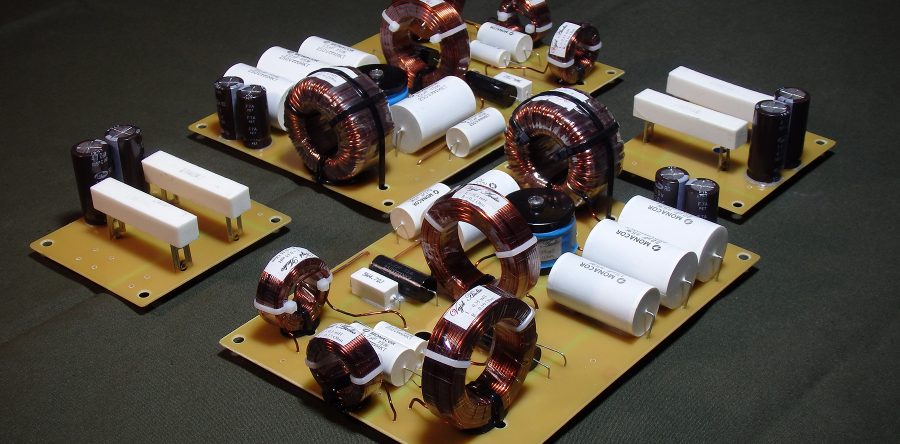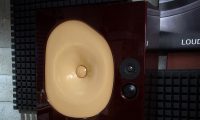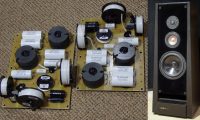New version of crossovers for these speaker systems

4-way speaker systems
Canton Ergo 120 DC
Listening. What’s wrong with the sound?
Subjectively: dominance of bass and high frequencies. The midrange is lowered.
A typical example of a “saddle-shaped” or “U-shaped” amplitude-frequency response.
You can learn more about “U-frequency” at the link:
FINE-TUNING OF SPEAKER SYSTEMS
Measurements of characteristics
Measurements fully confirm subjective feelings.
In the frequency response graph, we can see a hum at 100Hz, a -6dB drop in the midrange from 200Hz to 3kHz, and a smooth rise in the treble from 3kHz to 10kHz with a slope of 4dB/oct. Frequency response uniformity in the range of 30 Hz – 20 kHz is 8 dB (+/- 4)
By the way, the mid-frequency range is well balanced – its uniformity is +/-1.5 dB in the range of 200 Hz – 3 kHz. But, unfortunately, this positive fact cannot be heard due to its masking by the raised edges of the frequency response.
I did not measure the transfer functions of the original filters and impedance, I do not see the point in this, since it is quite obvious that the culprit of the “U-shaped” frequency response is the setting of the original crossovers.
New version of crossovers
I will immediately present the final frequency response of these systems with the new version of the crossovers for comparison:
In this version of the crossovers, I adjusted the frequency response close to uniformity of +/- 2 dB in the same range. Here it is important to note one nuance: the uniformity of the frequency response is ensured on the axis of the mid-frequency driver, which is located approximately at the height of the head of a seated listener. Therefore, in the filter circuit (which is shown below), the tweeter HF T and the upper midrange driver MF M38 are connected in-phase despite the 3rd order filters on either side. If you change the polarity of the tweeter, that is, turn it on in antiphase to the MF M38 driver, the frequency response will be equal along the axis of the tweeter.
Filter for woofers.
2nd order, it uses the original L2 4.7 mH inductor (huge, thick wire winding on an open transformer steel core), the coil is carried with separate fasteners inside the case. It fit perfectly without changes, so I left it working in the new version of the filters.
Regarding the divider of two powerful 20 W resistors, which is present in the low-pass filter circuit. I had to put it in the circuit because the sensitivity of the two LF W260 10-inch woofers exceeds the sensitivity of the MF M260 midrange driver. The amount of attenuation of the divider signal is -3dB. It comes to mind that one bass speaker in this design is clearly superfluous.
MF M160 midrange driver. Its sensitivity dictates the signal level for neighboring drivers. The filter for it is of the 2nd order on both sides without signal-limiting resistors.
Filters for MF M38 and HF T drivers: 2nd and 3rd orders with limiting resistors at the output of the filters before the drivers.
Polarity of inclusion of drivers MF M160, MF M38, HF T: in phase with each other and in antiphase to bass drivers LF W260.
Other measurements of the characteristics of acoustic systems with a new version of crossovers:
Frequency response slopes of separate graphs of filter transfer functions are formed “mirror” to the frequency response of the corresponding drivers to which they are connected. Which actually ensures a uniform total frequency response of the entire speaker system.
Impedance The average resistance is 4 Ohms with minimums of 2.8 – 3 Ohms at frequencies of 120, 450, 1700, 4800 Hz.
Construction of crossovers
It consists of two boards: a low-frequency filter and medium-high-frequency filters. The layout is similar to the original filter boards, the mounting holes are in the same places, so the new filter boards are installed in the standard places without modifying the fasteners inside the speaker box. Access to the crossover boards is carried out through the holes of the low-frequency drivers:
Other structural elements
Glass wool is used as a sound-absorbing material inside the box, so you need to be careful when disassembling/assembling crossovers. The material should cover all the inner walls of the box in one layer about 3 cm thick, after installing the crossover boards, the back wall of the box should also be covered with a sheet of sound-absorbing material.
Bass reflex port. It is tuned to a frequency of 25 Hz. But due to the very small cross-sectional area of the port compared to the total area of the woofer diffusers, it practically does not work. Apparently, the developer assigned a more decorative than functional role to the bass reflex port.
Drivers and their composition. Analyzing the design and characteristics of the drivers used in these speaker systems, I came to the conclusion that a couple of drivers from this set could be excluded from the composition without harming the sound quality, but significantly simplifying the design. One LF W260 woofer and one MF M38 midrange speaker. A pair of woofers, as I already mentioned, do not correlate well with other drivers in terms of sensitivity. The mid-range MF M38 is actually wedged between the MF M160 and the HF T, the characteristics of which are quite capable of mating with each other without the MF M38. Kind of like the Ergo DC 91 model, only with one woofer. But given the “U-shaped” frequency characteristic laid down by the developer, the drivers can be used in any combination. Drivers, by the way, are not of bad quality and with good characteristics.
Looking at the model range of the Ergo line from the 90s of the last century, it comes to mind that the developers were guided by the following idea: to create small speakers with two drivers (DC22, DC32), slightly larger ones with three (DC71), large ones with four (DC91). And the largest flagship model of the line with five speakers: Ergo DC 120.
Unfortunately, well-thought-out engineering solutions and high-quality sound tuning in the pursuit of creating a wide assortment, as a rule, are not a priority.
Sounding
When fine-tuning crossovers, I always try to create a sound that is as neutral and transparent as possible, without the dominance of certain frequency ranges, because an inaccurate timbral balance distorts the sound, makes it monotonous, not interesting.
Therefore, I offer CANTON Ergo DC 120 owners an upgrade of crossovers according to my schemes, which will really improve the sound quality and allow you to enjoy the sound to the fullest.
You can make it yourself if you have the skills and the necessary tools, including devices for accurately measuring the nominal values of parts. Or contact me (via this link) and order the production of crossover kits. It remains for you to correctly install the ready-made boards in your speaker systems.















